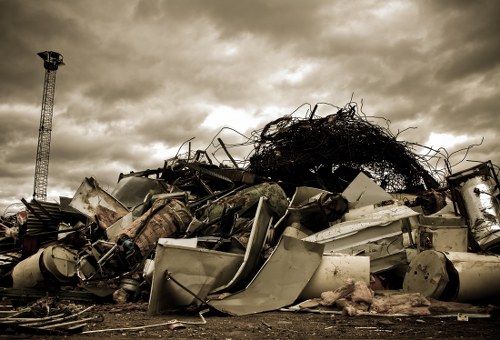Comprehensive Guide to Garden Clearance in Highgate
Why Garden Clearance is Essential

Maintaining a pristine garden requires regular garden clearance in Highgate. Over time, gardens can accumulate debris, dead plants, and unwanted structures that not only detract from the beauty of your outdoor space but also pose potential hazards.
Effective garden clearance enhances the overall aesthetics, ensuring that your garden remains a peaceful and inviting retreat. It also helps in preventing the spread of diseases among plants by removing infected or dead vegetation.
Furthermore, a well-maintained garden can significantly increase the value of your property, making it an important aspect for homeowners looking to sell or simply improve their living environment.
Services Offered in Garden Clearance

Professional garden clearance services in Highgate offer a comprehensive range of solutions tailored to meet diverse needs. These services typically include:
- Weed Removal: Eliminating invasive species that can choke your garden.
- Pruning and Trimming: Maintaining the shape and health of your plants.
- Debris Removal: Clearing away fallen leaves, branches, and other organic matter.
- Waste Disposal: Ensuring that all cleared materials are disposed of responsibly.
- Landscaping: Enhancing the layout and functionality of your garden space.
By availing these services, homeowners can ensure that their gardens remain not only beautiful but also safe and sustainable.
Investing in professional clearance services can save time and effort, allowing you to enjoy your garden without the hassle of manual upkeep.
Benefits of Choosing Local Highgate Experts

Opting for local garden clearance experts in Highgate offers numerous advantages. Local professionals are well-acquainted with the specific flora and environmental conditions of the area, enabling them to provide tailored solutions that align with your garden's unique requirements.
Moreover, local services often come with a deep understanding of community standards and regulations, ensuring that all clearance activities comply with local guidelines.
Another significant benefit is the prompt and reliable service that local providers can offer. Being in close proximity means quicker response times and more personalized customer support.
Steps Involved in Garden Clearance

Embarking on a garden clearance project involves several structured steps to ensure thorough and effective results:
- Assessment: Evaluating the current state of the garden to identify areas that need attention.
- Planning: Developing a clear plan that outlines the tasks and resources required.
- Execution: Carrying out the clearance tasks systematically, ensuring all debris and unwanted elements are removed.
- Disposal: Managing the proper disposal of cleared materials in an eco-friendly manner.
- Post-Clearance Review: Inspecting the cleared area to ensure all objectives have been met.
Following these steps ensures that the garden clearance process is organized, efficient, and leaves your garden in optimal condition.
Proper execution of each step is crucial for the overall success of the garden clearance project.
Eco-Friendly Clearance Practices

Incorporating eco-friendly practices in garden clearance not only benefits the environment but also promotes sustainability. Here are some green practices to consider:
- Recycling: Separating waste materials for recycling reduces the strain on landfills.
- Composting: Organic waste can be composted to create nutrient-rich soil for your garden.
- Minimal Use of Chemicals: Avoiding excessive use of herbicides and pesticides helps maintain soil health and biodiversity.
- Natural Pest Control: Utilizing natural predators and barriers to manage pests without harmful chemicals.
- Water Conservation: Implementing efficient watering systems to reduce water wastage during and after clearance.
Adopting these practices ensures that garden clearance contributes positively to the environment and supports the health of your garden ecosystem.
Eco-friendly clearance not only preserves the beauty of your garden but also protects the planet for future generations.
Costs Involved in Garden Clearance

The cost of garden clearance in Highgate can vary based on several factors, including the size of the garden, the extent of clearance required, and the specific services chosen. Typically, pricing structures may include:
- Hourly Rates: Charging based on the time spent on the clearance project.
- Flat Fees: A fixed price for a defined scope of work.
- Per-Hectare Pricing: Costs calculated based on the area of the garden.
- Additional Charges: Fees for specialized services such as tree removal or disposal of hazardous materials.
It's advisable to obtain detailed quotes from multiple providers to compare prices and ensure you receive value for your investment.
Transparent pricing and clear communication with service providers can help avoid unexpected costs.
Choosing the Right Service Provider

Selecting the appropriate garden clearance service provider in Highgate is crucial for achieving the desired results. Consider the following factors when making your decision:
- Experience and Expertise: Look for companies with a proven track record and knowledgeable staff.
- Licensing and Insurance: Ensure the provider is properly licensed and insured to protect against potential liabilities.
- Customer Reviews: Check testimonials and reviews to gauge customer satisfaction and service quality.
- Range of Services: Opt for providers that offer a comprehensive suite of services to meet all your clearance needs.
- Environmental Practices: Choose companies that prioritize eco-friendly methods and sustainable practices.
Taking the time to research and evaluate potential providers will help you find a trustworthy and competent partner for your garden clearance project.
A thorough selection process ensures that your garden clearance is handled efficiently and professionally.
Preparing for Garden Clearance

Proper preparation is key to a smooth and effective garden clearance process. Here are some steps to get ready:
- Identify Areas of Concern: Pinpoint sections of your garden that need the most attention.
- Clear Access Points: Ensure that service providers can easily access all parts of your garden.
- Communicate Expectations: Clearly outline your goals and preferences to the service provider.
- Secure Valuables: Remove any valuable or fragile items from the garden to prevent damage.
- Plan for Disposal: Decide how you want waste materials to be handled, whether recycled, composted, or otherwise.
By taking these preparatory steps, you can facilitate a more efficient clearance process and achieve the best possible outcome for your garden.
Good preparation minimizes disruptions and ensures that the clearance team can work effectively.
Maintaining Your Garden Post-Clearance

After completing the garden clearance, ongoing maintenance is essential to preserve the improved condition of your outdoor space. Regular upkeep includes:
- Routine Pruning: Keeping plants tidy and promoting healthy growth.
- Weed Control: Preventing the resurgence of unwanted vegetation.
- Soil Management: Ensuring the soil remains fertile and well-balanced.
- Seasonal Cleanup: Addressing specific needs during different times of the year.
- Irrigation Systems: Maintaining efficient watering practices to support plant health.
Implementing these maintenance practices helps sustain the benefits of garden clearance, ensuring your garden remains vibrant and enjoyable throughout the year.
Consistent maintenance is the key to long-term garden health and beauty.
Common Challenges in Garden Clearance

Garden clearance projects can encounter various challenges that may impede progress or affect the outcome. Some common issues include:
- Overgrown Vegetation: Extensive plant growth can be time-consuming to manage.
- Stubborn Weeds: Invasive weed species may require specialized treatment to eradicate.
- Debris Accumulation: Large amounts of organic matter can complicate disposal efforts.
- Access Constraints: Limited access to certain garden areas may hinder clearance activities.
- Safety Hazards: Potential dangers such as unstable structures or hidden obstacles.
Addressing these challenges requires careful planning, the right equipment, and experienced professionals who can adapt to unforeseen circumstances.
Proactive problem-solving ensures that garden clearance projects are completed efficiently despite obstacles.
Seasonal Considerations for Garden Clearance

Different seasons present unique considerations for garden clearance. Understanding these can help you schedule and execute clearance activities more effectively:
- Spring: Focus on removing winter debris and preparing plants for the growing season.
- Summer: Manage rapid plant growth and control pests.
- Autumn: Clear fallen leaves and dead plant material to prevent disease.
- Winter: Conduct structural maintenance and prepare the garden for the upcoming year.
Timing your garden clearance to align with seasonal changes ensures that your garden remains healthy and resilient throughout the year.
Seasonal planning enhances the effectiveness of garden clearance and supports ongoing garden health.
Tools and Equipment for Effective Clearance

Utilizing the right tools and equipment is essential for efficient garden clearance. Commonly used items include:
- Pruning Shears: For cutting and trimming plants with precision.
- Rakes: To gather leaves, twigs, and other debris.
- Hedge Trimmers: For maintaining the shape and size of hedges.
- Wheelbarrows: To transport cleared materials easily.
- Chainsaws: For removing larger branches and trees.
Having access to appropriate tools not only speeds up the clearance process but also ensures that tasks are carried out safely and effectively.
Investing in quality equipment can make a significant difference in the efficiency of garden clearance.
Safety Precautions During Clearance

Safety is paramount during garden clearance to prevent accidents and injuries. Key precautions include:
- Protective Gear: Wear gloves, safety goggles, and sturdy footwear to protect against hazards.
- Proper Training: Ensure that all personnel are trained in the safe operation of tools and equipment.
- Clear Communication: Maintain clear communication among team members to coordinate activities effectively.
- Hazard Assessment: Identify and mitigate potential dangers such as unstable structures or sharp objects.
- First Aid Supplies: Keep first aid kits readily available in case of emergencies.
Adhering to these safety measures helps create a secure environment for both workers and homeowners during the garden clearance process.
Prioritizing safety ensures that garden clearance is conducted smoothly without any mishaps.
Environmental Impact of Garden Clearance

Garden clearance can have significant environmental implications if not managed responsibly. Positive impacts include:
- Habitat Improvement: Removing invasive species allows native plants and wildlife to thrive.
- Soil Health: Clearing debris prevents soil erosion and maintains nutrient balance.
- Air Quality: Reducing plant litter minimizes the risk of fungal growth and improves air circulation.
Conversely, improper clearance practices can lead to negative consequences such as increased waste in landfills and disruption of local ecosystems.
Balancing garden clearance with environmental stewardship is essential for sustainable gardening practices.
Recycling and Reusing Garden Waste

Maximizing the recycling and reuse of garden waste is an effective way to minimize environmental impact. Here are some strategies:
- Composting: Convert organic waste into compost to enrich garden soil.
- Mulching: Use shredded plant material as mulch to retain soil moisture and suppress weeds.
- Reusing Materials: Repurpose branches and wood for DIY projects or as support structures for plants.
- Donation: Offer healthy plants and materials to community gardens or local organizations.
- Recycling Services: Utilize local recycling facilities for non-organic waste components.
Implementing these practices not only reduces waste but also promotes a more sustainable approach to garden maintenance.
Recycling and reusing garden waste supports environmental conservation and enhances garden health.
Enhancing Garden Design Post-Clearance

Following garden clearance, redesigning and enhancing the garden layout can further elevate its appeal and functionality. Consider the following design elements:
- Plant Selection: Choose a diverse range of plants that complement each other and thrive in your local climate.
- Pathways and Walkways: Create clear and aesthetically pleasing paths for easy navigation.
- Water Features: Incorporate elements like ponds or fountains to add tranquility.
- Seating Areas: Designate spaces for relaxation and social gatherings.
- Lighting: Install garden lighting to enhance beauty and safety during evening hours.
Thoughtful garden design post-clearance ensures that your outdoor space is not only clean but also inviting and enjoyable.
A well-designed garden enhances the overall living experience and increases property value.
Conclusion: The Importance of Professional Garden Clearance in Highgate

Professional garden clearance in Highgate is a vital service for homeowners seeking to maintain and enhance their outdoor spaces. It offers numerous benefits, including aesthetic improvement, increased property value, and environmental sustainability.
By choosing experienced local experts, employing eco-friendly practices, and adhering to safety standards, garden clearance can be both effective and responsible. Additionally, proper planning and maintenance post-clearance ensure that your garden remains a beautiful and healthy sanctuary year-round.
Don't let overgrown spaces detract from your garden's beauty. Contact us today to book your garden clearance service and transform your outdoor space into a serene and inviting environment.